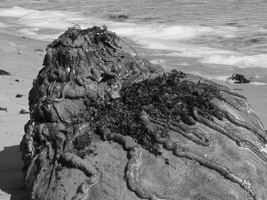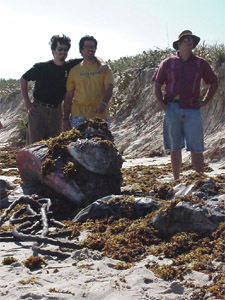Hunka, Hunka, Stinking Globster
Manteo, North Carolina - On September 5th, 1996, Hurricane Fran slammed into North Carolina with sustained winds in excess of 115 MPH. When it was over there were 24 people dead, five billion dollars in damages and a very interesting item washed up on the beach.

What the hell washed ashore in North Carolina?
|
"On the 6th me and some friends decided to go out to Cape Hatteras to see if there was any waves breaking." hurricane survivor Brad Abrahms (18 at the time) told me. "When we had to choose between cleaning up or going surfing, there was really no choice."
The national park, which is on one of the Outer Banks barrier islands, was still officially closed and in a state of disrepair. Brad and several friends got to the island and were disappointed to discover that the surge tide had piddled out and the waves were flat.. They were amazed at the huge amounts of seaweed that had been thrown on shore and began walking down the beach, looking at the destruction.
"Tad was joking that maybe we'd find some buried pirate treasure that had washed up. Well we didn't find gold. What we did find was this huge stinking mess."
Brad and his friends came upon a huge pile of rotting flesh that he estimated was approx. 20 foot long, 6 feet wide and over 4 foot thick in the middle section.
 "I thought maybe it was a dead whale or octopus that had been killed by the waves but it didn't look like anything." states Brad. " I mean it had no head or tail. There was these tentacle like things coming out from it but they just sort of came out at random points. It was like God's kid made some sort of animal while dad wasn't looking and it came out all wrong."
"I thought maybe it was a dead whale or octopus that had been killed by the waves but it didn't look like anything." states Brad. " I mean it had no head or tail. There was these tentacle like things coming out from it but they just sort of came out at random points. It was like God's kid made some sort of animal while dad wasn't looking and it came out all wrong."
Mysterious piles of dead flesh (or globsters as they are called by cryptozoologists) that wash ashore have been reported before. In 1896 2 men found a huge carcass on the beach of Anastasia Island, Florida. Reports from the time stated the section weighed upwards to 5 tons and was 23 feet long, 4 feet high and 18 feet across at it's widest point. It was thought to be a new species of octopus, and was photographed and written up for an article in the American Naturalist magazine. A zoologist, comparing the size of the creature with known octopus and squids, estimated that the total length when alive must have been around 200 feet. Later scientists discredited this theory and announced that it had been a sperm whale even though no bones were discovered in the carcass.
Another creature was found on a Tasmania beach in August of 1960. This one was said to have no head or eyes but with a peculiar coat of hairs covering the skin. Through delay and scientific bungling no correct scientific analysis was conducted of the beast. The affair ended when a Australian senator told the press that it was blubber, torn from a whale.
So was the creature found by Brad Abrahms related to these earlier globsters? Luckily for us one of the young men was carrying a camera and took pictures of his friends around the strange find. I asked noted cryptozoologist Vincent Trambetti to look at the photos and give me his assessment.
"The exterior of the carcass does resemble the descriptions of classic globsters." Trambetti told me over the phone. "The skin is a light gray in color and there seems to be several arms or tentacles coming from it. It reminds me of the one that washed ashore on Four Mile Beach Tasmania in 1997. Of course the anomalies are usually reported in the southern hemisphere or at least in warmer waters. It's possible that this one could have been transported hundreds of miles from it's original home by the hurricane. It's a pity that the boys didn't tell anyone about their find."
Since Brad and his friends were in the park illegally they didn't feel the need to report the find to anyone. The group forgot about the incident until a year and later when Brad's biology professor at the University of North Carolina at Wilmington brought up the subject of the 1896 case in Florida. Brad told his teacher about the incident on Cape Hatteras and showed him the pictures. The Professor sent copies of the images to the International Cryptozoology Association and it was in a ICA newsletter that the story was first heard by the public.
Cape Hattaras National Park Ranger Howard Sirrew said the staff at the park had found nothing unusual at the park during the cleanup. "We were pretty busy with our own homes and no one got out to the park until around the 17th and then we concentrated on getting the concession areas, campgrounds and stations back together. We didn't have time to patrol the beach and I imagine that whatever got washed up was eaten pretty quickly by the crabs and migratory birds."
sources
N.O.A.A. web site, www.ncdc.noaa.gov
interview with Brad Abrahms, March 10th, 1998
Cryptozoology and the Search for Hidden Animals, Darwin Gervers editor; 1997, NewZoo Press
phone interview with Vincent Trambetti, March 13th, 1998
"Did Hurricane Fran Wash Up A Globster?" International Cryptozoology Association newsletter vol. 10, November 1997
phone interview with Howard Sirrew, March 14th, 1998
photo courtesy of Brad Abrahms









